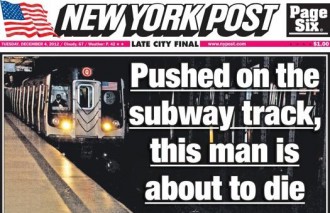
On a busy bridge in Detroit during a traffic jam, Deletha Word was pulled from her car by Martell Welch, whose car she had sideswiped. In view of more than forty people, former football-player Welch savagely beat Word, tearing off her clothes. Welch jumped off the bridge to escape her attacker and subsequently drowned. When I heard this story on the evening news back in 1996, I was horrified that not one of the many onlookers attempted to stop Word’s attack or to pull her from the river (she initially survived the fall, but couldn’t swim). I will never forget my first introduction to the “Bystander Effect,” the social phenomenon in which individuals are less likely to intervene to help someone in distress if there are other people nearby.
The Bystander Effect was highlighted again recently as a result of the notoriously-tactless New York Post’s front-page publication of photographs of a man about to be killed by an oncoming New York City subway train. The man had been pushed onto the tracks after an altercation was struggling to get back onto the platform. Facing criticism for photographing the man’s death, rather than helping pull him from the tracks, the photographer has defended himself in the media. He’s said he could not have gotten to the victim in time to save him, but by taking photos—thus causing his camera’s flash to go off and possibly alert the driver of the train—he hoped to help. Plus, many other people were closer to the man, but did nothing to pull him up.
Arguably, social media has exacerbated the Bystander Effect. Tim Knapp, a sociologist at Missouri State University, commented in an article about the NYC incident, “Now everyone can be a journalist and some times, at the expense of being a good Samaritan.” That is, no longer are onlookers passive observers who “do not want to get involved” or risk their own personal safety; now many bystanders film or photograph the incidents in which they fail to intervene.

Comments 3
Friday Roundup: December 21, 2012 » The Editors' Desk — December 21, 2012
[...] “Bystander Journalism?” by Erin Hoekstra. In which the bystander effect goes high tech. [...]
December Media Award for Measured Social Science » Citings and Sightings — January 26, 2013
[...] great use of this concept to explain current events, TSP is happy to award her article, written up as a citing by board member Erin Hoekstra, the media award for [...]
Barroom Bystanders » Citings and Sightings — August 6, 2013
[...] get crazy, the “bystander effect” can kick in. As seen in many public incidents (notably when bystanders took photos of a man about to be killed on NYC train tracks), the bystander effect is generally considered a powerful force in determining whether someone [...]